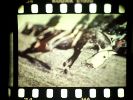Eye For Film >> Movies >> Riding Zorro (2011) Film Review
Riding Zorro
Reviewed by: Andrew Robertson

The horse was dappled, splashes of pale on a strong dark body, unbridled, unbowed, unbroken - his name came from his white face, an implacable equine mask. Zorro, they called him - Zorro the greatest, Zorro the undefeated, Zorro the killer.
This is Zorro's story, heavily intermediated - video, projections upon projections, developing film, interviews and home movies. This is a story of rodeo, of revenge, of, perhaps, redemption. It's also impenetrable, muddied, slipshod, and most disappointingly boring.

Translation is a difficult art - no denial - but Riding Zorro makes life harder with basic errors in the subtitles, compounding it with a frequent reliance on the technical vocabulary of rodeo, at least as practised near Rio Plata. There's one striking moment where the islands are referred to in text as the Falklands, but elsewhere the issues are more prosaic. There are, it seems, classes or types of rodeo riding, perhaps relating to where the rider starts on the horse - but is it "corse" or "course" or "coarse"? There are references to "clines", which might be haunches, but statements like "the invict on bastos and worktop" and "with his buzzle he turned around my dredge" defy ready interpretation.
Based on interviews done in 2006, archive footage, there are sections of Riding Zorro that are startlingly pretty: cine film projected, a section of white card used to highlight particular moments, particular sections; different moments projected, a hand of someone unseen painting directly on the surface, an impressionistic portrait underneath impressionistic footage; photographs developing, a section's title card printed out and left in a stream; at times the faded video and film become blurry and romanticised, like watercolours in a mid-Western motel bedroom.
There are also moments that strongly disappoint: at one point we watch footage shot on video, projected, then re-filmed on another camera, the first footage played in massive zoom, slow motion, until we've only the whisper of a suggestion of a notion that something is happening, otherwise it's varicoloured squares dancing like they have been tranquilised.
Zorro was a famous horse - even before he killed - we talk to riders various, the photographer who followed him for a season or two, an owner perhaps, a breeder. There are some clippings, the aforementioned archival film. The titles seem designed to invoke a dossier, an image of distressed paper and a typewriter font over the top. It's not the only place where it seems to be trying to hard, which is all the more galling as there are places where it doesn't seem to have bothered at all.
There are moments of startling imagery - the simplicity and effectiveness of the multi-layered projection surface cannot be over-stated, it's a beautiful notion, well used - but there are conspicuous absences. A tighter edit, for a start - it lingers, perhaps a legacy of having only so much of these interviews, no chance for a followup. More careful translation, a technical primer on rodeo as practised, even a diagram of a horse - fetlock and mane and hoof - Zorro himself changes drastically, from a youthful masked piebald to a baleful pale, and while we see that progression the opportunity for contrast is missed.
There's a strobe-like sequence, good music by Raul Fernandez, and an interesting story concealed within, but for a horse as sure-footed as Zorro this is a stumbling, plodding disservice.
Reviewed on: 29 Jun 2012

















